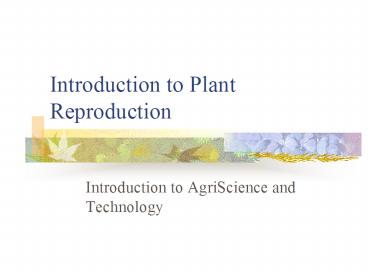Introduction to Plant Reproduction - PowerPoint PPT Presentation
Title:
Introduction to Plant Reproduction
Description:
List and explain the different types of flowers. Complete. Incomplete. Complete Flowers ... An incomplete flower is one that lacks one or more of the four principal ... – PowerPoint PPT presentation
Number of Views:79
Avg rating:3.0/5.0
Title: Introduction to Plant Reproduction
1
Introduction to Plant Reproduction
- Introduction to AgriScience and Technology
2
Objective 1.1Define Propagation
- Propagation
- The reproduction of plants either sexually or
asexually.
3
Objective 1.2Define sexual reproduction and the
terms associated with it.
- Sexual Reproduction
- The union of the female and male sex cells to
produce a seed (embryo). - Ovule female sex cell.
- Pollen male sex cell.
- Embryo (seed-germ) an immature plant.
- Sexual reproduction involves the creation of a
genetically new individual.
4
Objective 1.3List and explain the different
types of seeds.
- Monocots
- Seeds with one seed leaf.
- Leaves have parallel veins.
- 1 solid seed.
- Stem vacular bundles scattered.
- Roots are adventitious
- Flowers in multiples of three.
- Pollen with single furrow or pore
5
Dicots
- Seeds with 2 seed leaves or 2 cotyledons
- Veins are webbed.
- Pollen with three furrows or pores.
- Flowers parts in multiples of four or five.
- Stem vascular bundles in a ring.
6
Monocots
7
Dicot Leaf
8
Dicot
9
10
Objective 1.4List and explain the different
types of flowers.
- Complete
- Incomplete
11
Complete Flowers
- Sepals
- The outer part of the flower.
- In open flowers, the sepals are found at the base
of the plant.
12
PetalsThe brightly colored, soft tissue that
attracts insects.
13
Stamens
- The male part of the flower that has an anther at
the end of it to produce pollen.
14
Pistil
- Stigma
- The opening of the pistil.
- Style
- The tube-like structure that connects the stigma
and ovary. - Ovary
- The site of fertilization and growth of the seed.
15
Stigma, Style Ovary
16
Ovary
17
Complete Flower
18
Complete Flower
19
Incomplete Flower
- An incomplete flower is one that lacks one or
more of the four principal components identified
in a complete flower.
20
Objective 1.5Explain the difference between a
perfect and imperfect flower
- A perfect flower is one with both the stamen and
pistil - An imperfect flower is one that lacks one of the
sex organs.
21
Objective 1.6Define pollination, fertilization
and germination.
- Pollination
- The transfer of pollen from an anther to a stigma
of a flower of the same species. - Fertilization
- The union of the pollen and ovule cells.
- Germination
- The sprouting of a seed.
22
Objective 1.7Define asexual reproduction
- Asexual Reproduction
- The reproduction of a plant without the uniting
of a pollen and ovule. - Asexual reproduction is often referred to as
vegetative propagation since no seed is involved
in the formation of the new plant. - It is known as a clone.
- Leaves, stems or roots may be used to grow a new
plant. - Produces a genetically identical plant.
23
Objective 1.8List the benefits of vegetative
propagation.
- True traits of the parents
- Maintains genetic purity with
- 100 replication of parent plant.
- No seed
- Some plants do not produce a seed or the seeds
are too small to work with. - Accelerates the time it takes to get a new plant
to the market - Traditionally, it would take up to 40 years to
get a new plant to the general public however,
micropropagation can yield marketable levels of
plants within 8 to 12 years.
24
Objective 1.9List and explain the different
types of vegetative propagation.
- Layering
- Involves getting roots to grow from the stem.
I.e., magnolia tree - Cutting
- Using a short section of plant stems for
propagation. - Budding
- Taking a bud from one plant and moving it to
another. - Grafting
- Placing a section of a stem of one plant onto
another plant. - Tissue culture
- Taking a group of cells or a single cell and
growing it to a plant.
25
Layering
26
Cutting
27
Tissue Culture































